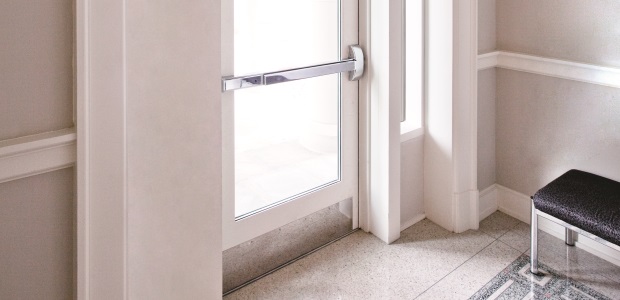
Maintaining Fire Compliant Openings
While most people using institutional and commercial buildings worry most about security issues these days, fires strike far more often than those types of emergencies.
- By David Kase
- Mar 01, 2017
A building's doorways serve multiple purposes to those who live, work, or visit the facility. They provide a convenient and safe conduit in and out of the building, they offer security, and they can play an important role in protecting occupants in the event of a fire emergency.
The fire code requirements on openings vary depending upon the buildings' uses. However, all openings have one thing in common: Although doors and exit devices may have been compliant with fire code regulations upon installation, there's no guarantee they'll stay that way.
Exit devices, when installed on new openings, work nicely. But when things deteriorate—doors begin to sag or otherwise don't fit or function as before—people become concerned about security and look for DIY ways to secure it. Unfortunately, most people aren't knowledgeable about what's required from a fire safety perspective, or they want to keep expenses minimal and will do anything they can to avoid spending money on fire code-compliant doors and door hardware.
Another problem is that people unintentionally make it difficult to find or access emergency exits by placing furnishings and objects in front of doors when they don’t know where else to store those items. And believe it or not, sometimes murals or other décor are used to make emergency exits blend in with their surroundings.
Those actions jeopardize occupants' well-being and could have dire consequences.
Building codes constantly evolve to better protect people in the event of fire emergencies. Unfortunately, those codes are only effective to their full potential when building owners, property managers, construction professionals, locksmiths, and door hardware professionals make checking compliance a priority for the long term. The ongoing inspections needed to ensure existing openings are compliant don't always happen.
Some of the risky situations I've either seen or heard of include:
- Highchairs stacked in front of a restaurant's emergency fire exit
- A church's fire exit hidden by a stage curtain
- Motorcycles lined up in front of a fire exit at a motorcycle shop
- An elementary school dance where teachers placed a display and table in front of the emergency exit
- Emergency exits purposely locked with deadbolts
- On numerous occasions, when locks aren't working correctly, I've seen people tape the latches into the door so they don't have to fix them. (It's very important that doors latch in case of a fire.)
For the most part, these actions are taken in ignorance rather than blatant disregard of the rules, but the end result could be disastrous either way if a fire emergency would occur.
According to Pennsylvania State Fire Commissioner Timothy Solobay, "While most municipalities have building code inspectors or code persons who check to ensure new buildings or buildings that have new ownership are up to code, not all have fire inspectors who visit industrial, commercial, and multi-family properties annually to make sure they’ve remained up to code."
Key Fire Code Regulations
Some of the key fire code regulations for openings that people tend to overlook after initial installation include:
NFPA 101—Chapter 7: Means of Egress
An increase in thefts, muggings, and similar crimes has led to the practice of providing extra security on door assemblies within the means of egress. This occurs most often where door assemblies to exit stairs and exit discharges are found. The provisions of 7.2.1.5 are aimed at preventing locked door assemblies in means of egress.
NFPA 80—Chapter 15-2.3
Door openings and the surrounding areas shall be kept clear of anything that could obstruct or interfere with the free operation of the door.
NFPA 101—Chapter 70-2.1.5.3
Locks, if provided, shall not require the use of a key, a tool, or special knowledge or effort for operation from the egress side.
To ensure that these and other regulations are met long past when an opening and door hardware are installed, industry professionals need to be vigilant in educating building owners, property managers, and users of facilities. While most people using institutional and commercial buildings worry most about security issues these days, fires strike far more often than those types of emergencies.
With the primary focus of Solobay's office on fire safety education and training, he agrees that proactively arming property owners and people managing and using facilities with knowledge of safety hazards at exits helps to minimize fire risks.
Ongoing inspections can help to an even greater degree. But for municipalities without fire inspectors, who will take on that responsibility?
Fire safety experts suggest hardware manufacturers and others in our industry offer free inspections to building owners.
I see positive possibilities in that for property managers, facility occupants, and manufacturers. Not only would it open the door to educating facility managers, but it would also give manufacturers the opportunity to sell hardware. That's a win-win situation. Safer exits could result in lives saved and long-term revenue potential.
This article originally appeared in the March 2017 issue of Occupational Health & Safety.